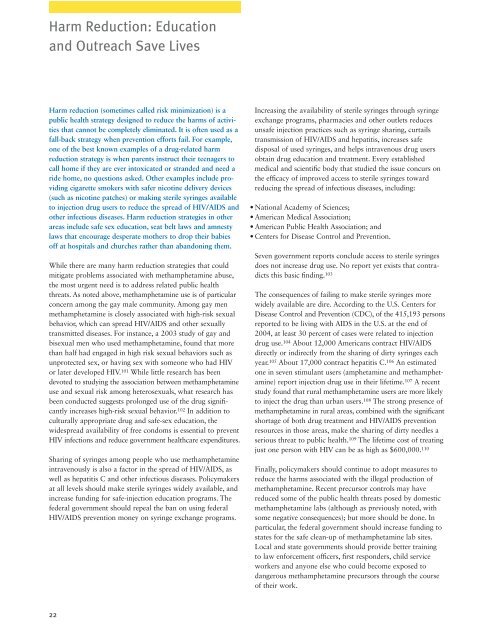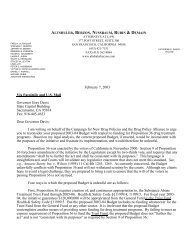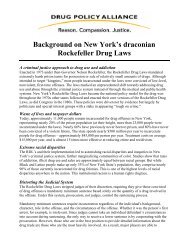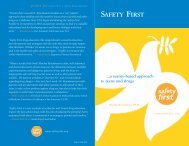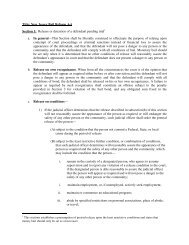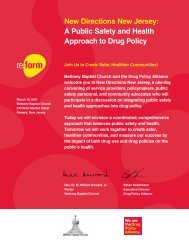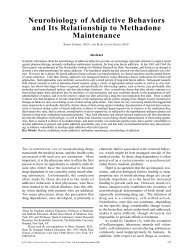A Four Pillars Approach to Methamphetamine - Drug Policy Alliance
A Four Pillars Approach to Methamphetamine - Drug Policy Alliance
A Four Pillars Approach to Methamphetamine - Drug Policy Alliance
You also want an ePaper? Increase the reach of your titles
YUMPU automatically turns print PDFs into web optimized ePapers that Google loves.
Harm Reduction: Education<br />
and Outreach Save Lives<br />
Harm reduction (sometimes called risk minimization) is a<br />
public health strategy designed <strong>to</strong> reduce the harms of activities<br />
that cannot be completely eliminated. It is often used as a<br />
fall-back strategy when prevention efforts fail. For example,<br />
one of the best known examples of a drug-related harm<br />
reduction strategy is when parents instruct their teenagers <strong>to</strong><br />
call home if they are ever in<strong>to</strong>xicated or stranded and need a<br />
ride home, no questions asked. Other examples include providing<br />
cigarette smokers with safer nicotine delivery devices<br />
(such as nicotine patches) or making sterile syringes available<br />
<strong>to</strong> injection drug users <strong>to</strong> reduce the spread of HIV/AIDS and<br />
other infectious diseases. Harm reduction strategies in other<br />
areas include safe sex education, seat belt laws and amnesty<br />
laws that encourage desperate mothers <strong>to</strong> drop their babies<br />
off at hospitals and churches rather than abandoning them.<br />
While there are many harm reduction strategies that could<br />
mitigate problems associated with methamphetamine abuse,<br />
the most urgent need is <strong>to</strong> address related public health<br />
threats. As noted above, methamphetamine use is of particular<br />
concern among the gay male community. Among gay men<br />
methamphetamine is closely associated with high-risk sexual<br />
behavior, which can spread HIV/AIDS and other sexually<br />
transmitted diseases. For instance, a 2003 study of gay and<br />
bisexual men who used methamphetamine, found that more<br />
than half had engaged in high risk sexual behaviors such as<br />
unprotected sex, or having sex with someone who had HIV<br />
or later developed HIV. 101 While little research has been<br />
devoted <strong>to</strong> studying the association between methamphetamine<br />
use and sexual risk among heterosexuals, what research has<br />
been conducted suggests prolonged use of the drug significantly<br />
increases high-risk sexual behavior. 102 In addition <strong>to</strong><br />
culturally appropriate drug and safe-sex education, the<br />
widespread availability of free condoms is essential <strong>to</strong> prevent<br />
HIV infections and reduce government healthcare expenditures.<br />
Sharing of syringes among people who use methamphetamine<br />
intravenously is also a fac<strong>to</strong>r in the spread of HIV/AIDS, as<br />
well as hepatitis C and other infectious diseases. <strong>Policy</strong>makers<br />
at all levels should make sterile syringes widely available, and<br />
increase funding for safe-injection education programs. The<br />
federal government should repeal the ban on using federal<br />
HIV/AIDS prevention money on syringe exchange programs.<br />
Increasing the availability of sterile syringes through syringe<br />
exchange programs, pharmacies and other outlets reduces<br />
unsafe injection practices such as syringe sharing, curtails<br />
transmission of HIV/AIDS and hepatitis, increases safe<br />
disposal of used syringes, and helps intravenous drug users<br />
obtain drug education and treatment. Every established<br />
medical and scientific body that studied the issue concurs on<br />
the efficacy of improved access <strong>to</strong> sterile syringes <strong>to</strong>ward<br />
reducing the spread of infectious diseases, including:<br />
• National Academy of Sciences;<br />
• American Medical Association;<br />
• American Public Health Association; and<br />
• Centers for Disease Control and Prevention.<br />
Seven government reports conclude access <strong>to</strong> sterile syringes<br />
does not increase drug use. No report yet exists that contradicts<br />
this basic finding. 103<br />
The consequences of failing <strong>to</strong> make sterile syringes more<br />
widely available are dire. According <strong>to</strong> the U.S. Centers for<br />
Disease Control and Prevention (CDC), of the 415,193 persons<br />
reported <strong>to</strong> be living with AIDS in the U.S. at the end of<br />
2004, at least 30 percent of cases were related <strong>to</strong> injection<br />
drug use. 104 About 12,000 Americans contract HIV/AIDS<br />
directly or indirectly from the sharing of dirty syringes each<br />
year. 105 About 17,000 contract hepatitis C. 106 An estimated<br />
one in seven stimulant users (amphetamine and methamphetamine)<br />
report injection drug use in their lifetime. 107 A recent<br />
study found that rural methamphetamine users are more likely<br />
<strong>to</strong> inject the drug than urban users. 108 The strong presence of<br />
methamphetamine in rural areas, combined with the significant<br />
shortage of both drug treatment and HIV/AIDS prevention<br />
resources in those areas, make the sharing of dirty needles a<br />
serious threat <strong>to</strong> public health. 109 The lifetime cost of treating<br />
just one person with HIV can be as high as $600,000. 110<br />
Finally, policymakers should continue <strong>to</strong> adopt measures <strong>to</strong><br />
reduce the harms associated with the illegal production of<br />
methamphetamine. Recent precursor controls may have<br />
reduced some of the public health threats posed by domestic<br />
methamphetamine labs (although as previously noted, with<br />
some negative consequences); but more should be done. In<br />
particular, the federal government should increase funding <strong>to</strong><br />
states for the safe clean-up of methamphetamine lab sites.<br />
Local and state governments should provide better training<br />
<strong>to</strong> law enforcement officers, first responders, child service<br />
workers and anyone else who could become exposed <strong>to</strong><br />
dangerous methamphetamine precursors through the course<br />
of their work.<br />
22


